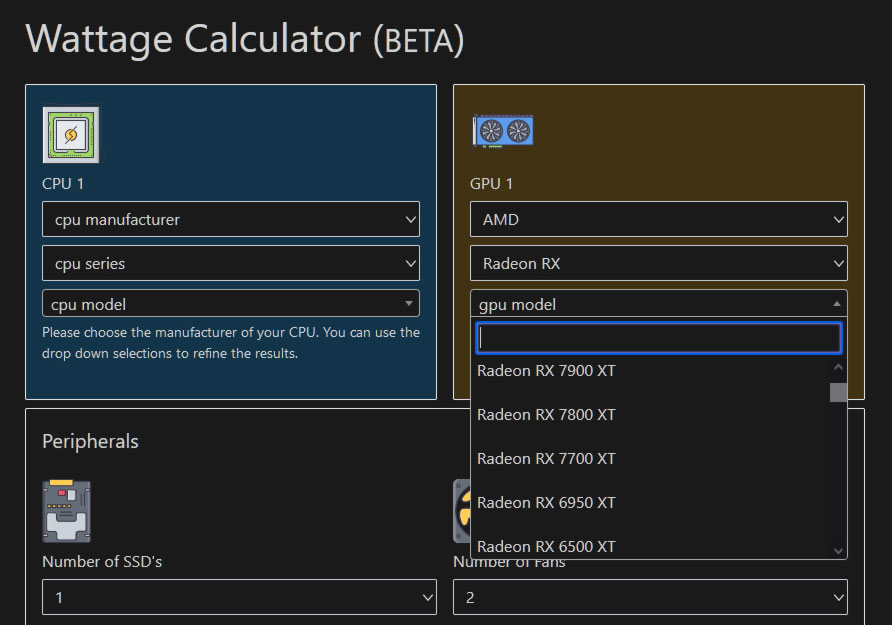Seasonic PSU Wattage Calculator Includes AMD Radeon RX 7000 Series GPUs
AMD Radeon RX 7900 XT, RX 7800 XT and RX 7700 XT feature in the online PSU calculator.
Seasonic's official Power Supply wattage calculator page has been updated to support the AMD Radeon RX 7000 series of GPUs. Twitter user SkyJuice spotted the 'error.' According to Seasonic's handy web tool, AMD's upcoming RDNA 3 graphics cards will consume similar amounts of power as their predecessors.
If you head on over to the Seasonic wattage calculator page now, you'll be greeted with a simple but functional page. You can select components from a series of drop-down lists and then press 'calculate' to get a page full of Seasonic PSU recommendations.
According to the tool, a mid-range modern Core i5 system packing an AMD Radeon RX 6700 XT requires at least a 650W PSU. Swapping the GPU out to the unannounced RX 7700 XT and recalculating results in the same minimum recommendation — a 650W PSU. The database Seasonic uses also appears to hold wattage values for the Radeon RX 7800 XT and the RX 7900 XT. Below you will see the figures we got from plugging in the unannounced RX 7000 series cards and their current-gen counterparts.
|
GPU |
Graphics card power (W) |
Recommended PSU (W) |
|---|---|---|
|
AMD RX 7900 XT |
NA |
750 |
|
AMD RX 6900 XT |
335 |
750 |
|
AMD RX 7800 XT |
NA |
750 |
|
AMD RX 6800 XT |
300 |
750 |
|
AMD RX 7700 XT |
NA |
650 |
|
AMD RX 6700 XT |
230 |
650 |
|
Nvidia RTX 3070 |
220 |
750* |
|
Nvidia RTX 4060 |
220+* |
750* |
The above PC system was configured in Seasonic's calculator with an Intel Core i5-12400, a GPU as above, twin SSDs, twin system fans, and no HDDs. *Please note that Seasonic recommends a 750W PSU for the system configured with an RTX 3070, but Nvidia says it is OK with a 650W PSU. Additionally, our article about GeForce RTX 4060 power requirement rumors is based on a source saying the upcoming RTX 4060 may consume more power than the current RX 3070 graphics card.
The above results are interesting to see with users concerned about the ballooning power requirements of discrete GPUs for PCs. There have been a number of rumors of very high power requirements for next-gen PC GPUs. If this AMD information is accurate it could be a good sign for fans of the red team as they await some official RNDA 3 architecture and product announcements.
Seasonic's PSU calculator also features the Radeon RX 6700 non-XT, which was listed by Sapphire last week but isn't yet an official product on AMD's website.
Readers should add a pinch of salt to the above data found on the Seasonic website. It is possible but unlikely that these are input errors. However, they could just be using placeholder figures rather than basing their calculations on data on the next-gen GPUs supplied by AMD.
Get Tom's Hardware's best news and in-depth reviews, straight to your inbox.

Mark Tyson is a news editor at Tom's Hardware. He enjoys covering the full breadth of PC tech; from business and semiconductor design to products approaching the edge of reason.
-
dalek1234 If these were "placeholder figures" for AMD's upcoming 7xxx series, one would think that we'd also see these "placeholder figures" for upcoming 4xxx series from Nvidia, but don't.Reply
"Input Errors"? Not sure about that either. That's a lot of "input errors".
It look s more like "AMD provided Seasonic with the wattage figures, but Nvidia didn't". Why? Perhaps Nvidia doesn't want to disclose this dirty-little-secret until they absolutely have to. We will know soon enough. -
jareeymonda Reply
Based on the calculator, it suggests that AMD's RDNA 3 series GPUs will have comparable maximum power consumption to the GPUs they are replacing. This implies that AMD has focused on maintaining power efficiency while delivering improved performance. By optimizing the architecture and manufacturing process, AMD can offer better performance within similar power consumption limits. This is beneficial as it allows users to upgrade their GPUs without needing to make significant changes to their power supply or cooling systems.Admin said:Using the calculator appears to indicate that AMD's RDNA 3 series GPUs will have similar max power consumption figures to the cards they replace.
